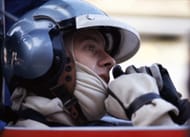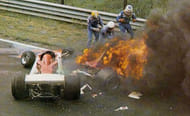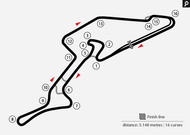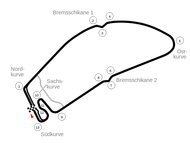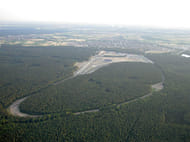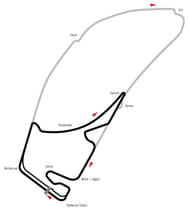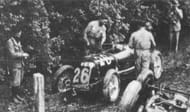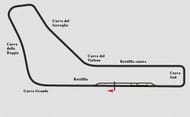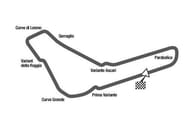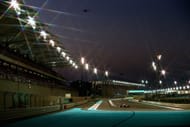Formula One cars have long been admired for their high speed and the thrill they deliver to viewers. An average 2014 car can reach a top speed in excess of 200kmph.
Being the pinnacle of motorsport, F1’s quest for speed is only natural. From a layman’s perspective, the best car has to be the fastest one, shouldn’t it? But over the past decades, developers have been forced to reduce speeds due to a number of issues.
One of them is the engine. Cars during Michael Schumacher’s heyday were powered by V10 engines. Then, in 2006, V8 engines were introduced, and from 2014 onwards, F1 cars have been running V6 engines.
Another reason, perhaps the most important one, is safety. Despite some spectacular crashes and freak incidents, Ayrton Senna’s unfortunate death still remains the last one seen in the sport. To prevent a repeat of any such eventuality, designers have been improving on-board safety year by year.
It’s not just the cars that have been evolving though; the tracks have also kept up with them. Gone are the days of racing through kilometres of dense forests. The focus these days is on the show as a whole, and not just the cars.
Lap-times have been cut down, the area enclosed by the track has been reduced drastically, and multi-circuit complexes have been developed – all in the interest of catering to spectators. It is believed that the Yas Marina complex in Abu Dhabi can run 3 races simultaneously.
It was a scary experience to see Felipe Massa’s car overturn in Germany, or even Kimi Raikkonen slamming the wall in Silverstone for that matter. Kimi’s accident occurred on a relatively short straight at very high speed, and yet, the impact measured 48 G. Both walked away from the scene immediately.
A few decades ago, such accidents would occur on longer straights and at much higher speeds, and sometimes, result in instant death.
Here is a look at the history of track redesigns at some of the most high-profile F1 circuits:
Nurburgring
One circuit which has seen many unfortunate incidents is the Nuerburgring. It is rumoured that up to 12 deaths occur at the Ring every year, when the old track is used to hold a variety of events.
Old layout
Situated to the south of Cologne, the track was nicknamed “The Green Hell” by former winner Jackie Stewart. Lap times during the years from 1947 to 1970 rarely breached the 9 minute mark. The track was riticized for being too dangerous, and the death of Piers Courage in 1970 prompted a change in layout.
As a result, Armco safety barriers were introduced, and some bumps repaired. But one problem still remained – distance. 22km of road was way too much for television cameras to cover, and the track’s position among the mountains made it difficult to distribute enough number of marshals. Also, during rain, parts of the circuit were wet, and parts of it dry.
Niki Lauda was the first to voice these fears, and ironically, he was the one to almost fall victim to the track. In the 1976 race, his life was saved only because some drivers stopped by and rescued him from his burning Ferrari. The German Grand Prix was shifted to Hockenheim from the next year onwards.
The period between 1976 and 1984 was one for rebuilding. Run-off areas were added to some corners like Aremberg and Bruennchen. More bumps were repaired and barriers were added, existing ones repaired. Bushes on the edge of the road were replaced by grass, and the road smoothened.
With these minor changes, the German Grand Prix returned to the Nordschleife in 1984 and 1985, before moving out again due to off-track issues.
New layout
The track, in its present layout, returned to F1 in 1995 and ran, till 2006, as the European Grand Prix with the exception of 1996 and 1997 (when it was called the Luxemberg Grand Prix). Since 2007, it has been alternating with Hockenhiem to host the German Grand Prix, with the race being held at the latter venue in even-numbered years.
For comparison, the older version was more than 22km long, with the lap record (unofficial) set by Niki Lauda in 6:58.2 seconds. On the other hand, the new one is just 5.1 km long.
Hockenheimring
Old Layout
The Hockenheimring is situated about a couple of hours’ distance from the Nuerburgring. The track has similar roots, with origins in the 1930s. The old circuit, 8km in length, mainly consisted of two long straights; with a long “Eastern” corner joining them. It was not intended for F1 while it was constructed though, since it played host to motorcycle events.
After the war, Grand Prix racing was held for the first time, with the addition of a stadium section towards the end of the lap. The section was called that because most of the spectators were seated there. The rest of the circuit remained unchanged for a decade.
Following Jim Clark’s and Patrick Depailler’s fatal accidents in the 1960s, new chicanes and Armco barriers were added.
These are marked as turn set 2,3,4 and turn 5 respectively.
The above format of the track consisted of four long straights, each of roughly 1.3km in length. The long flat hairpin at turn 5 was, in particular, a very dangerous corner.
Later, a chicane was added at the hairpin (bottom left part of the above image) due to safety issues.
But just like the Nuerburgring, there was one major problem – most of the overtaking happened on the long straights in the forest. Spectators got to see the cars only in the stadium section, a sector where the road was so narrow that there was least probability of overtaking.
This issue came to light at the German Grand Prix of 2000. In dynamic weather conditions, Rubens Barichello came through the field to win the race from 18th, overtaking most competitors in the straights.
Another major problem surfaced during the 1980s. It was the era of turbo-power in F1, which meant that fuel was restricted to a particular volume at the start (refuelling wasn’t allowed). The characteristics of the track meant it was difficult for most drivers to finish the race. Most famously, during the 1986 Grand Prix, Alain Prost ran out of fuel and tried to push his McLaren towards the line, before running dry. He was classified sixth. Ultimately, the points proved invaluable in him winning the championship that year.
Coming back to the race in 2000, it was a turning point in the track’s history. Apart from Barichello’s charge, Jean Alesi’s massive crash was the major talking point. A spectator came to his rescue before the marshals could. This highlighted major security and safety issues in the forest section of the track.
New Layout
Thus, the track was redesigned yet again in 2002, to its current format. This was a drastic change from previous versions. It completely avoided the forest section. The area enclosed by the circuit was reduced by half, and a totally new middle section was added. The map below shows both the forms.
The current circuit measures 4.5km in length. Kimi Raikkonen’s McLaren holds the lap record (1:13.780 in 2004).
This new circuit avoids the long straights through the dense forests, but still retains a pull as a high speed track. The start finish straight, the straight after turn 1, the hairpin and Sachs corner are the places to overtake. During the redesign, the stadium section was the only part of the track that was left untouched.
Despite the changes, the new version has drawn mixed responses.
Monza
Old Layout
The 10km long track was officially opened in 1922, and held its first race in that year. Like most of the old Formula One circuits, Monza is famous for its long straights and hence gets its nickname – “The temple of speed”.
Monza has claimed the lives of many drivers in the past, and maybe, the most horrific accident was that of Emilio Materassi in 1928. The crash even resulted in the death of more than 25 spectators.
In 1933, Monza claimed the lives of three more drivers – Giuseppe Campari, Mario Umberto Borzacchini and Count Stanislas Czaykowski. All lost their lives at the same sector, the south banking of the track. This put the death toll at Monza to nine in its 11 years of existence, leading to a rethink.
An alternative circuit, named Florio, was used from 1935 to 1937. Only one half of the oval segment was used, and a chicane was added in its course. The distinct feature of this layout was the addition of two 90 degree turns to switch between the two parts, entering the oval from the Rettifilo Centrale straight. The idea was to use this circuit while a new one was being built. The altered circuit hosted a race from 1938 up to 1954, with the exception of the war years.
Monza has been on the F1 calendar every year since 1955. The circuit used for the 1955 race was a combination of the high speed road section, and the oval section. This recreated the 10km racetrack of the old Monza.
As soon as the oval returned, the track claimed another victim – Wolfgang von Tips. The Dutchman’s car was sent flying into the stands after a collision with Jim Clark at Parabolica.
Following concerns over the banking, dangerous speeds and bumps along the road, the oval section was deemed too unsafe for F1. It was used for the last time in Formula One in the year 1969. A decision was made to replace the oval with a new road circuit, with a wider road, and with new safety barriers and fences.
The 1971 race was the last Italian Grand Prix held without chicanes. In 1972, a chicane was added at the end of the start finish straight before Rettifilo, and another one at Curva del Vialone. This was done owing to newer technology – speeds were increasing and the flat out sections had become unsafe for racing.
Minor changes, like the construction and expansion of stands, making larger kerbs, and improvement of pit-lane capacity continued till 1978.
New Layout
In the 1990s, the chicane at the end of the start finish straight was changed from right-left to left-right, with a gravel trap. A run-off area replaced the gravel in 2007, to form the current layout. The lap measures 5.8km in distance. Overtaking is usually done along the back straight leading to Parabolica, along the start finish straight, along Curva Grande, and approaching Della Roggia. Straight line speed holds the key here.
The Monza circuit has been redeveloped over the years on almost the same patch of land (consisting of the high-speed road section and the steeply banked oval section), unlike the two German circuits which delved into forests. Apart from Formula One, Monza also hosts vintage car and motorcycle events.
Other tracks
All the historic Formula One racetracks on the calendar have seen major modifications over the years – the Hungaroring, the Spa Francorchamps and Imola, for example. Even the Monaco Grand Prix hasn’t been spared of change despite the unique challenge it offers.
Among all, Monza, Nurburgring and Hockenheim are the ones that I feel have the richest history, the ones worth some extra attention. That said, the new and modern circuits like the ones in Abu Dhabi, Texas and Shanghai are believed to be equally challenging for both drivers and engineers.
In Abu Dhabi, temperature and humidity pose the biggest challenge, while in Texas, the challenges are terrain differences and the tight corners. In case of Shanghai, it is a toss between setting up the car for best performance down the long back straight, or gaining time from the slow sector 2 and the long sweeping right handers.
With the administrators looking at new tracks every year, and concentrating more than ever on safety, even these tracks will have to change over time to stay in contention. This means that some of the existing ones might even have to go out of the calendar.
There were reports of Bernie considering the future of Monza after 2016. I understand that the sport has to move on, that the new tracks can fetch more bucks, but can they provide the old-world charm of tracks like Monza? Will they have scope for modifications in the minor area that they may be built upon? Only time will tell.
One thing is for certain though. F1 or no F1, tracks like the Nurburgring, Hockenheim and Monza are well entrenched in the history of Formula One. Whatever happens, they will forever hold a special place in the hearts of drivers and spectators alike.
